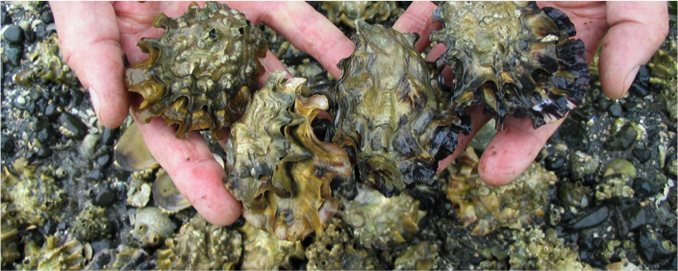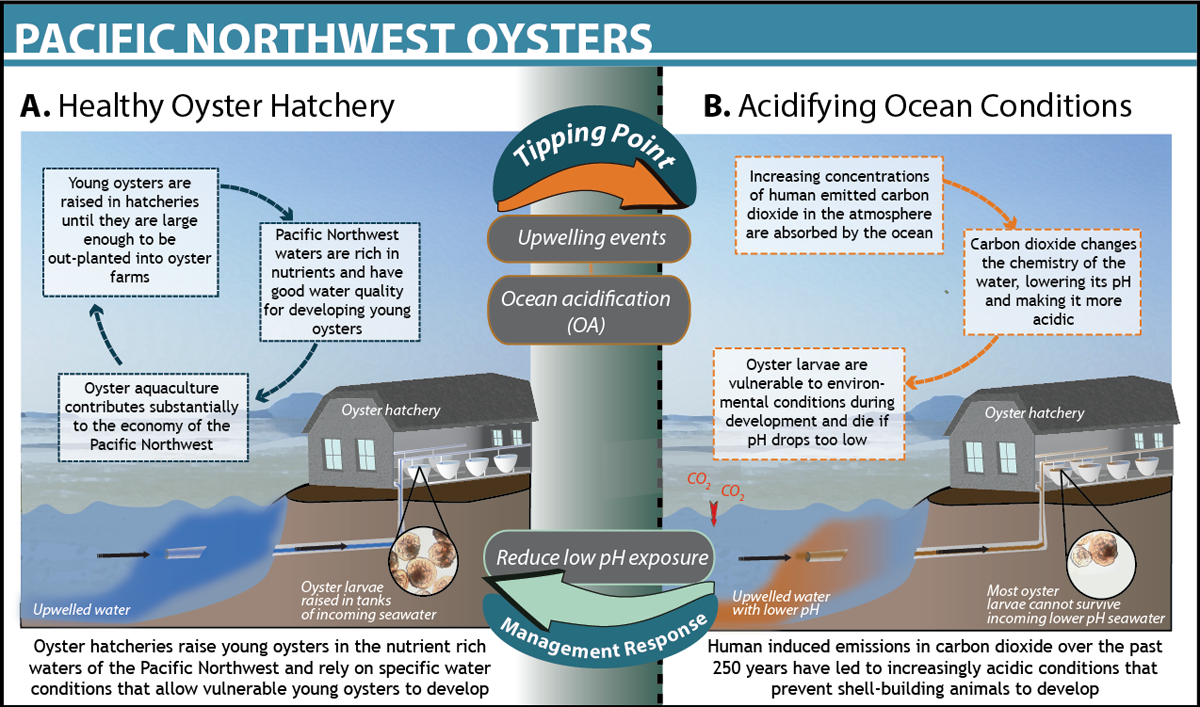Oyster aquaculture in the US Pacific Northwest is being threatened as ocean acidification prevents the survival of young oysters in hatcheries
Tipping points for oysters in the Pacific Northwest
The waters of the Pacific Northwest support a variety of productive fisheries including oysters, clams, and mussels, which thrive in the cold, nutrient-rich waters that are periodically upwelled from the deep ocean to the surface along the western coast.1 Oysters in the Pacific Northwest are one of the largest contributors to the $110 million dollar West Coast shellfish industry and support over 3,000 jobs.2 Beginning in 2005, oyster farmers began seeing massive die-offs of up to 80% of their oyster larvae, or “seed”.3 Young oysters are particularly vulnerable to environmental conditions during the first few days of life when they develop roughly 90% of their body weight as calcium carbonate shell.4 The inability of young oysters to develop during this critical period in their lifecycle is an indicator of a significant change in ocean conditions.
The deep upwelled water that bathes the Pacific Northwest coast naturally carries higher concentrations of dissolved carbon dioxide and lower pH, and species native to the region have evolved over time to withstand these natural, periodic fluctuations in pH. However, since the industrial era began over 250 years ago, humans have rapidly increased the amount of carbon dioxide in the atmosphere.1 Over one-third of carbon dioxide in the atmosphere is absorbed by the ocean,1 changing the chemistry of the water and driving a process known as ocean acidification where the pH of the ocean lowers and becomes more acidic.5 Since 1970, the ocean has become 30 percent more acidic and is expected to become increasingly acidic over the century.5
When pH becomes too low, young oysters' shells disintegrate. When these ocean conditions limit oyster larvae’s ability to survive, oyster hatcheries are left with no larvae to distribute to oyster farms along the coast.
How Managers Tackled the Problem
Recognizing the threat of acidification to the regional economy, local culture, and coastal environment, commercial oyster fisheries began investing in research to better understand the underlying cause of the massive die-offs of oyster larvae. Researchers identified ocean acidification as the major cause of the massive mortality events between 2005 and 2009.6 Following this finding, the federal government further invested $500,000 in monitoring equipment for coastal seawater in order to acquire real-time data on ocean conditions.2 Initial solutions have relied on managing around the problem, e.g., by limiting seawater input to larvae tanks to times when conditions were known to be acceptable to young oysters.4 Other short-term solutions included adding basic chemicals, such as sodium carbonate (baking soda), to incoming seawater tanks, and relocating oyster hatcheries to more tropical locations, which are less vulnerable to ocean acidification. The collaboration between oyster fishermen and scientists in the Pacific Northwest has resulted in many growers recovering nearly 77 percent of their losses.7 However, while these strategies help resource users adapt to current conditions, ocean acidification is expected to become more severe in the coming decades, requiring new solutions.5
In 2012, Washington State Governor Christine Gregoire created a panel on ocean acidification (“Panel”) made up of scientists, industry representatives, and local, state, and federal policymakers.1 Their purpose was to understand the state of ocean acidification science, identify the research and monitoring needed to improve management, develop recommendations to respond to acidification's harmful effects, identify opportunities for improved coordination and partnerships, and enhance public awarenss.1 Plans for action include reducing global, national, and local carbon emissions that perpetuate ocean acidification, decreasing nutrient runoff to coastal waters that may exacerbate acidification by strengthening and augmenting existing laws, and increasing the region’s ability to adapt to and remediate the impacts of ocean acidification.1
What We Can Learn
The collaboration among governments, industries, scientists, policy-makers, and public officials on the Panel illustrates the value of interdisciplinary cooperation to effectively address large-scale tipping points. Understanding that ocean acidification is the main driver of the massive oyster mortality observed in the region, policymakers and stakeholders have been able to focus on and plan for local management that may alleviate some of the negative consequences of acidic conditions. In the short-term, expanded monitoring and research may yield new remediation or adaptation solutions for the shellfish industry. As ocean acidification becomes more severe and corrosive to the coastal environment of the Pacific Northwest though, solutions will need to focus on both large-scale causes, such as carbon emissions, and local drivers, such as air and land pollution that exacerbate ocean acidification and add stress to marine organisms. A greater understanding of how ecosystems may respond to increasingly acidic conditions will also help managers and decision makers continue to prepare and adapt for changes in the future.
As the Ocean Tipping Points team has come to understand, the most successful scenarios for resource management occur when management is threshold-based, populations are monitored routinely, and the geographic scale for management is relatively small.
Learn more about our Management Review research and Ocean Tipping Points project.






